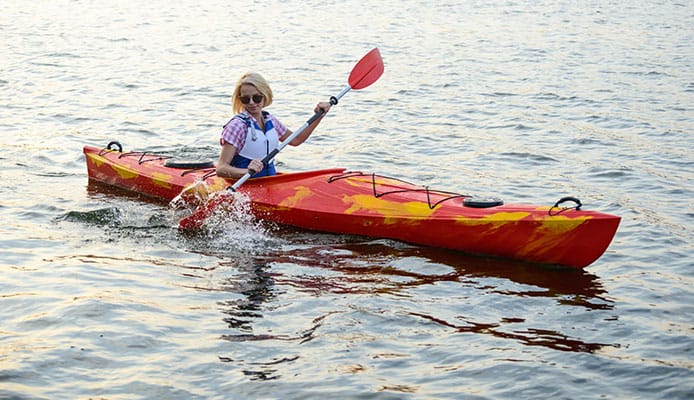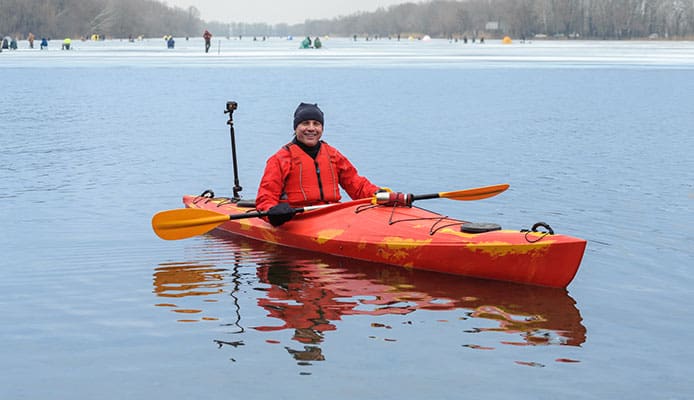
On the surface, kayaking may seem like just sitting on a kayak, gripping the paddle, and slicing the water. Well, that may be the easiest way to explain what kayaking is to a novice but the truth is, there is way more to it than meets the eye.
This is an activity that involves your entire body. The moment you grab your kayak paddle and start rowing, you involve almost all the major muscle groups and joints, not only your arms.
And you don’t have to spend the entire day on the water to reap the health benefits of kayaking. 30-45 minutes a day is all you need to shed some weight and tone any group of muscles used in kayaking.
5 Important Muscles Used In Kayaking
Kayaking uses your shoulder, arm, lower back, core, and leg muscles, which is why it is considered one of the most cardio-intensive workouts we have today. Let’s find out how each of the muscles in these body parts is involved.
1. Back Muscles
When you start to paddle, your back muscles, also known as latissimus dorsi, pull torque power from the lower part of your body and transfers it to the upper part of your body including the arms, to facilitate movement. When one of your arms strikes the water, the other one stretches and extends.
The lower back plays a huge role in paddling. It provides the right posture for your upper body so it can paddle properly. If you are not doing your rowing the right way, the back muscles will help set your upper body to proper posture so it doesn’t strain.
To have the most comfortable paddling experience, and avoid kayaking backaches and pains, you must invest in the right kayak seat and install an adequate backrest. This will also provide additional support so your back muscles don’t feel worn out than they should be.
You might also like: How To Easily Tow A Kayak?
2. Shoulder Muscles
Many people, before they start learning how to kayak think that shoulders don’t play any role in kayaking except connecting the arms to the core muscles and that’s why shoulder injuries are so common in beginner paddlers. It’s very easy for the force exerted by the water on the paddle to torque your shoulder if it happens to get your arms out of your paddler box.
So what muscles do kayaking work around your shoulders? You may wonder!
When you row your kayak, deltoids, the muscle group that shapes the top of your shoulder is forced to work with your arms. Every stroke forces it to contract and elongate, which places it under intense tension. After some strokes, your shoulders will start feeling sore and things may remain this way during the first days of your kayaking. But once you get used to the routine, your muscles will get used to it, and you will feel less pain.
3. Forearms And Hand Muscles
Another group of muscles used in kayaking is the forearms and the grips. These are undoubtedly some of the most important muscles because they help you maneuver the paddle properly. Whether you want to rotate, twist, or extend your wrists, your forearms and hands will make moving and holding your paddle easier. The hands act as the pivot as you rotate the paddle.
Make sure not to grip the paddle too tight, as this will force you to use more energy to slice the water. As a result, your forearms will wear out quickly and can even put you at risk of developing arthritis in your hand joints.
If you are paddling in calm waters, maintain a fairly loose grip. Of course, for white water kayaking or any other kayaking trip where you will be encountering rough conditions, you will need to make your grip a little tight so you don’t lose your paddle.
4. Arm Muscles
Any paddling activity works both your upper and lower arm muscles. However, the triceps will be working more than the biceps. If you are using a double-edged paddle blade, you will be providing a consistent workout to your arms because both of them will be doing a similar activity. As one of the arms slices the water, the other one extends forward providing the extra energy needed to propel the kayak.
Like any other water sport that involves paddling, when we start to kayak, we tend to use our arms more than our bodies. However, once we have learned the ropes, despite the contraction and expansion of the arm muscles to provide power, our bodies get more involved in the movement.
5. Leg Muscles
For people who have never paddled a kayak or canoe and beginners, it is hard to imagine how legs are part of kayaking and they may wonder, “Exactly what muscles does kayaking work in the lower body?” Surprisingly, your leg muscles are greatly involved with the whole activity since they connect the watercraft to your torso and the rest of your body.
You may not notice this but when you paddle your kayak, the legs bend and turn your upper body, which gives the shoulders and arms the energy they need to move your boat forward. The legs provide proper bracing against the walls of your kayak, which helps with maneuvering, turning, paddling, and maintaining stability.
As you get used to kayaking and learn the best way to do it, you will understand how your legs work in conjunction with your entire body to make your kayak adventure more enjoyable. Sore legs will be as a result of using a kayak too small or one that is not outfitted properly. So ensure you have adjusted your boat before setting out.
Globo Surf Overview
Apart from enjoying the serene marine life, kayaking gives you a full-body workout. It is one of the greatest ways to strengthen your muscles and have a leaner body. If you are new to kayaking, make sure to pay attention to all the muscle groups we have discussed above and maintained a proper posture to avoid stress, soreness, and injury.
More Skils Guides:
- Plastic Kayak Repair Guide
- How To Properly Strap Two Kayaks Into A Car Roof Rack
- How To Roll A Kayak
- How And Where To Sit In A Kayak
- How To Do Kayak Edge And Brace Stroke
- How To Paddle A Tandem Kayak
- What Is A Kayak Wet Exit And Entry And How To Properly Do It?
- How to Carry a Kayak: The Right Way!
- How to Get In and Out of a Kayak


